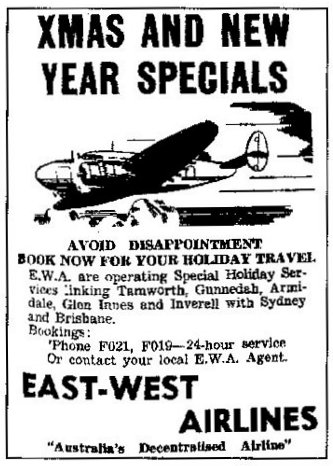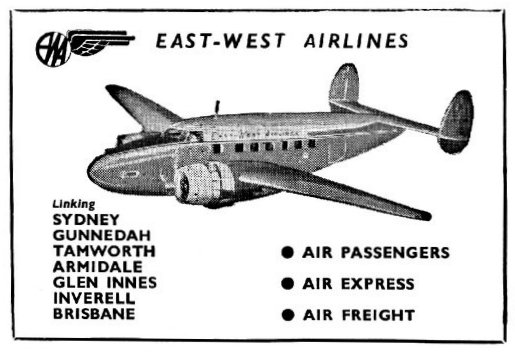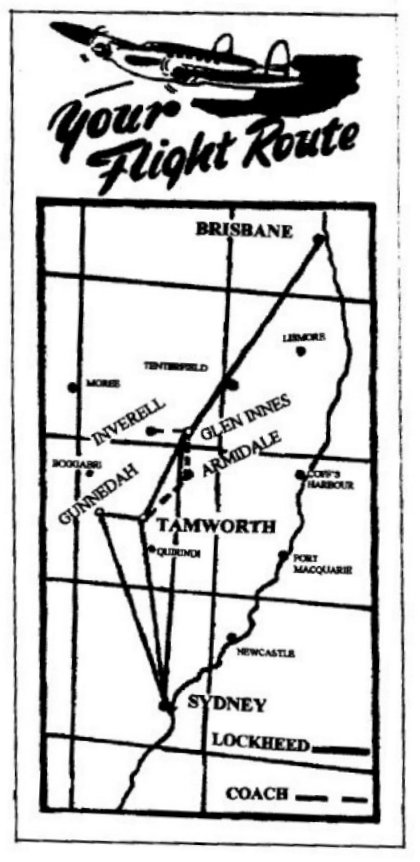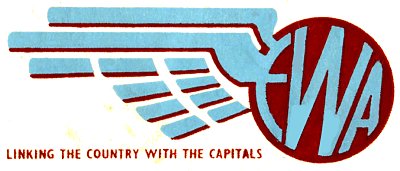|
East-West Airlines - The Hudson Eraby
|
|
This
is Part 2
|
| Over many
years when East-West operated long-distance "Air Tours" across
Australia, the company Directors stated the financial stability
of the company was due to these tours bringing in good revenue,
particularly at times of low regular air service activity. The
pioneer of these flights departed Tamworth on March 29, 1951
when Hudson VH-EWA carried 13 local residents and three crew
to Adelaide via Mildura and on to Alice Springs before returning
through Broken Hill to Tamworth. The success led to another
more extensive tour in June and then a series of tours each
subsequent year all operated by Hudsons until 1957 when DC-3
aircraft were used. One flight made by East-West Hudson VH-EWB which caught media attention was an emergency flight from Tamworth to Alice Springs. On Saturday, April 28 1951, a stockman was seriously injured in a horse fall outside Alice Springs and needed urgent medical attention at a major hospital. Calls by the Ambulance Superintendent at Alice Springs for an aircraft were directed to East-West who made the Hudson available at very short notice. The Flight Superintendent, Captain Smith and Tamworth based Captain Chris Braund along with Hostess Marj Ross elected to crew the aircraft on its mercy dash. Departing Tamworth at 8.00pm with the air ambulance kit installed, the Hudson flew a direct track to Alice Springs, some 1829kms away, where it arrived at 1.16am local time after nearly 5 hours flying. After refuelling and checking the aircraft, a 3 hour rest was had by the 3 crew members before the Hudson departed Alice Springs at 6.30am for Sydney. After 4 hours and 52 minutes flying, the Hudson touched down at Sydney’s Mascot airport where the injured man was transferred to a waiting ambulance. While refuelling, the airline agent was requested to load as much freight as he had into the Hudson during the quick turnaround. The weary crew departed Sydney at 12.30pm and 75 minutes later landed at Tamworth where the aircraft was handed over to the engineers for checking and servicing before it again departed on the 3.15pm service to Sydney and return. The new Gunnedah aerodrome was officially opened on May 12, 1951 where Hudson VH-EWE was officially named Namoi City but it wasn’t until the 14th that the first Gunnedah - Sydney service was flown by the Hudson. This date also marked the introduction of Hudsons on to all flights except Armidale which was served by a connecting Anson flight from Tamworth which also continued to Glen Innes twice weekly to connect with the Tamworth - Glen Innes - Brisbane Hudson service. The June 30, 1951 meeting of Directors instructed the Manager to insure Hudsons VH-EWA, VH-EWB and VH-EWE for £15,000 each while reducing the insurance on the remaining two serviceable Anson aircraft to £500 each. |

Advertising
special Christmas flights.
Northern Daily Leader – December 4, 1951
|
The frustration
at the authorities not acting on the Armidale aerodrome problem
culminated in the final Anson service to the city being flown
on October 27 by VH-EWZ, thus ending all Anson passenger flights
by East-West Airlines. It wasn’t until December 1956 that the
aerodrome was re-opened following which services were mainly
flown by DC-3 aircraft supported at peak times by Hudsons. |

"Gordon's Air Guide" early 1953.
| For
the next 20 months, Hudson aircraft operated all East-West
services until the airline purchased its first DC-3 on July
22, 1953. For the year ending 30th June 1952, the Hudson
fleet carried 26,403 passengers while the following year
they carried 28,531 passengers and a record 353,603kgs of
freight and mail. In early 1953 a decision was made to relocate the Tamworth aerodrome to a new site some 8kms west of the City along the Gunnedah Road. Work commenced in November with East-West officials hoping to have the airline relocated there towards the end of 1955 even though runways were to be completed by the end of 1954. The loss of Hudson VH-EWA during a ground engine run accident at Mascot airport during June 1953 brought forward by two years, the entry into service of company owned DC-3 aircraft. Earlier on May 13, chartered T.A.A. DC-3 aircraft were introduced to fly a Sydney – Gunnedah – Tamworth - Sydney service each Wednesday and a similar but reversed routing each Thursday. On each day, a connection was made at Tamworth with a Hudson service from Brisbane and Glen Innes. Ownership of VH-EWA was officially transferred to Adastra Aerial Surveys Pty Ltd on July 1, 1953 after all insurance moneys were received for the damaged aircraft. These were immediately passed to Qantas Airways as the down payment for the DC-3 VH-EAM which was delivered to Tamworth on July 22, 1953. |

Last
Hudson advertisement.
"Gordon's Air Guide" – July 1953:

1953 Flight Folder Showing Hudson Routes.
| The
two remaining Hudson aircraft continued to play a big
part in the fortunes of East-West and following the
purchase of the company structure, route licences and
goodwill of South Coast Airways Pty Ltd on August 1,
1953, the sphere of operation by the Hudsons moved from
northern NSW to the western centres of Cowra and West
Wyalong. At the East-West monthly Board meeting held
on August 26, it was resolved to transfer ownership
of Hudsons VH-EWB and VH-EWE to South Coast Airways
Pty Ltd. On May 2, 1954 Hudson VH-EWB flew a party of East-West officials from Tamworth to Coolangatta as a trial flight to investigate the possibility of commencing regular flights from northern centres to the popular holiday region. Flights commenced sometime later in August 1955 but with DC-3 aircraft. The official 1954 Christmas holiday period commenced on Friday, December 24 which put considerable strain on East-West flights to Tamworth and other centres. To allow flights to be made to other centres as well as Tamworth, special permission was received from DCA to operate night flights into the new aerodrome even though no passenger facilities were ready. The timetable showed the evening flights to be:
They
further resolved: |
Special Thanks
|
The
East-West Hudsons
The East-West Hudsons
| Registration | Acquired | Disposed | Remarks |
|---|---|---|---|
| VH-EWA | JAN50 | 03JUL53 | Sold to Adastra Aerial Surveys |
| VH-EWB/EWS | 21DEC50 | 10SEP62 | Sold to Herald Flying Services |
| VH-EWE/EWR | 20NOV50 | 13AUG62 | Sold to Adastra Aerial Surveys |
| A16-124 | 12FEB49 | 51/52 | Conversion abandoned. |
The
Other Four
The Other Four
As
related in the preceding narrative, East-West
purchased six Hudsons from Brigadier MacArthur-Onslow
(t/a Macquarie Grove Flying School). Of these
six airframes we can identify only two:
Macquarie Grove Flying School (MGFS) purchased a total of 11 Hudsons from disposals. Of these, two were sold to Herald Flying Services (A16-120 & 199 which became VH-SML and VH-SMM respectively). From East-West board minutes we know that one of the three aircraft towed to Tamworth was A16-124 which was indeed one of the eleven aircraft sold to MGFS. This leaves the following as possible candidates for the remaining four: A16-127, 130, 143, 148 - all Mk IV A16-180, 189, 207, 229 - all Mk III Although it is tempting to speculate that East-West might have chosen only Mark IV Hudsons, we have seen elsewhere that conversion from a Mk III to a Mk IV and vice versa is not an obstacle. Given a choice of many airframes and many spare engines, an operator would most likely select the superior airframes and change the engine type if necessary. Therefore, it is unlikely that we can draw any valid conclusions from the above list of candidates. As we will see in the case of As an added complication, UPDATE 15 March 2017: In July 1950, East-West Airlines expressed interest in Guinea Airways' Lockheed 14 VH-AEW which was stored in the open at Parafield. Although DCA reported that the aircraft could be made flyable in approximately one week, EWA apparently lost interest in the aircraft. |
East-West Hudson Colours and Markings
EAST-WEST HUDSON GALLERY
| An
unidentified Hudson at the old Tamworth Aerodrome.
Probably one of the five Hudsons that never
entered service with East-West. Photo: Chris O'Neill |
|
| Hudson
VH-BNJ at Mascot in 1951. Photo: Peter Ricketts |
|
| Hudson
VH-EWA at Mascot. Note open nose compartment
door. Photo: Ed Coates |
|
| Hudson
VH-EWA at Brisbane, Eagle Farm. Photo: Grulke Collection |
|
| Hudson
VH-EWB. Photo: Ed Coates |
|
| Hudson
VH-EWE. Photo: East-West Airlines via Roger McDonald Collection |
|
| Hudson
VH-EWE. Photo: Ed Coates Collection |
|
| Hudson
VH-EWE. This image is linked to detailed close-ups
of the East-West Airlines markings. Photo: Geoff Howarth via Queensland Air Museum |
|
| The
cabin of an unidentified East-West Hudson. Photo: Geoff Howarth via Queensland Air Museum |
|
| Hudson
VH-BPT in rainmaking configuration. Photo: CSIRO |
|
|
Special
Projects Division Hudsons. |
| Issue | Date | Remarks |
|---|---|---|
| 7 | 15MAR17 |
Added
a reference to an expression of interest
by EWA in acquiring L-14 VH-AEW.
|
| 6 | 03FEB16 |
Refreshed
images.
|
| 5 | 09JUN14 |
Refreshed
layout.
|
| 4 | 17OCT01 |
The
last paragraph has been rewritten with
new information which clarifies the
role of the Shell Company in the acquisition
of Hudson A16-112.
|

Return to The Lockheed File










